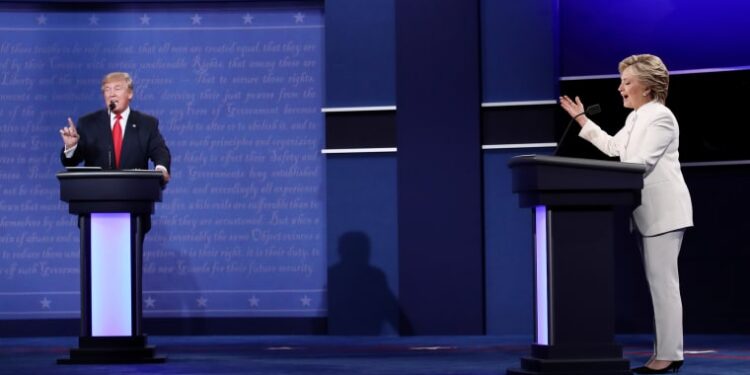Battleground polls look bad. Forecasting models are gloomier. States assumed to be safely in their column now seem in play.
The realization that their presidential candidate has no realistic path to victory is sweeping the party. Panicked leaders are speaking out, more and more by the hour. Dozens are now publicly demanding their candidate exit the race. And the other party is licking its chops, thinking big not just about a win but about a landslide up and down the ballot.
It’s happening now with Democrats and President Joe Biden, yes, but it’s also happened before. It was eight Octobers ago when Republicans erupted in panic at the latest — and most dramatic, to date — uproar around their nominee, Donald Trump. The release of the “Access Hollywood” tape convinced scores of major Republicans that Trump’s path to victory had gone from small to nonexistent, and a frantic 36-hour push to dislodge him from the top of the ticket ensued. You know the rest.
How and why Trump prevailed, even after his party’s leaders disowned him, is worth keeping in mind as (at least as of this writing) Biden refuses to relent to similar pressure.
There will always be debate over what exactly put Trump over the top, but however you arrive at it, one critical variable does stand out: his opponent’s profound unpopularity.
From the early days of the 2016 race until the end, barely 40% of voters expressed favorable views of Hillary Clinton. For the entire general election campaign, even as Trump paraded from one scandal and inflammatory eruption to another, Clinton proved stubbornly incapable of even reaching 50% support in the national poll averages. In the exit poll, 61% deemed her dishonest and untrustworthy. A majority said they would be “scared” or “concerned” if she were president.
In all of these areas, Trump’s numbers were just as bad. And in other areas, they were far worse. On Election Day, 61% of voters said Trump was unqualified to serve as president. Even more, 63%, said he lacked the basic temperament for the job. And 70% said his treatment of women bothered them.

These were all supposed to be threshold questions. After all, who would say they dislike a candidate and that the candidate is unqualified, unfit and dishonest — and then vote for that candidate anyway? Trump owes his 2016 victory to a not insubstantial number of voters who did just that. That’s how unacceptable they deemed the alternative to be.
The hope for Biden, in the event he remains a candidate, is that Trump serves as the Hillary Clinton of 2024: an opponent so objectionable to so many voters that a critical chunk of them ultimately side with Biden, even while believing that the incumbent lacks some of the most basic attributes needed in a president.
While Biden is by no means in a good position in current public polling, the numbers hardly rule out this possibility.
Our latest NBC News poll, released early this week, offers a set of findings for Biden that are, by any historical standard, grim. Among registered voters, 58% disapprove his job performance, 53% have a negative personal view of him and 65% say his physical and mental health represents a “major” concern. Only 33% of Democrats say they’re satisfied with him as their party’s nominee.
And yet, in our poll, Biden still trails Trump by just 2 points, 45%-43%. That’s the same deficit he faced in our previous poll, back in April. And it comes weeks after his horrendous debate showing and amidst increasingly harsh criticism from his own party.
It suggests that, as shocking as Biden’s public performance was for many of his allies, most Americans had long ago recognized and processed his decline. Earlier polling data backs that up. And many of those voters had also long ago concluded that they’d still prefer a clearly diminished Biden to another Trump term. Notably, Trump’s negative rating in our poll is 53%, the same as Biden’s. It certainly seems that Trump’s very real weaknesses are at least keeping Biden in the game.
Now, there’s always a “to be sure” section in an analysis like this, so here it goes. To be sure, we don’t yet know the full political effect of the GOP convention or the Trump shooting. It could be that Trump actually grows his support to new levels and gains significant new popularity. If that were to happen, any comparison to Clinton in 2016 would collapse.
It’s also true Trump already enjoyed a substantial Electoral College advantage in both 2016 and 2020, when he lost the popular vote by millions of votes. Based on that, the fact that Trump is ahead by any margin in national polling — something that was essentially never the case in the previous two elections — would seem to suggest that he’s not just ahead but far ahead in the battlegrounds. And, indeed, recent swing state polling has generally been more favorable to Trump than national polling.
But there’s also reason to suspect that Trump’s Electoral College advantage will be significantly reduced, maybe even eliminated, this time around, due to the changing nature of his demographic coalition. If true, then a small Trump lead in national polling wouldn’t be as dire for Biden. And while there are some high-quality swing state surveys now in circulation, state-level data from well-established pollsters is much less abundant than at the national level.
It can’t be underscored enough: Biden’s position in polling is not good at all. But a lesson from Trump’s 2016 victory is that, if antipathy toward the alternative is intense enough, voters will stretch the limits of what they are ultimately willing to accept far beyond anything previously understood to be the case. Whether that could actually include re-electing a president they don’t believe has the basic fitness for the job remains to be seen — maybe.






